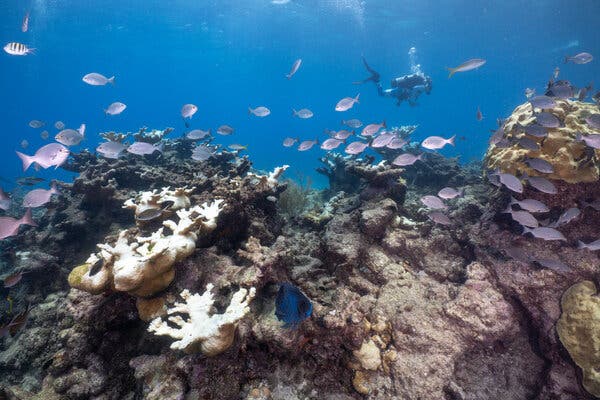
A Desperate Push to Save Florida’s Coral: Get It Out of the Sea
Teams dedicated to ocean restoration are urgently moving samples to tanks on land as a marine heat wave devastates entire reefs.
When Bailey Thomasson first spotted the coral, she felt a jolt of relief. She was diving for samples off the Florida Keys, and the thicket of elkhorn coral below looked brown, not the stark white that would indicate bleaching from the record-breaking sea temperatures in the area. But as she swam closer, she realized the situation was far worse than she’d considered possible.
“The coral didn’t even have a chance to bleach, it just died,” said Ms. Thomasson, who works for the Coral Restoration Foundation, a nonprofit group based in the Keys. The brown color was not healthy coral but dead tissue sloughing off the skeleton, almost as if it had melted.
“It just felt like, ‘Oh my God, we’re in the apocalypse,’” she said. “What’s happening?”
With climate change ravaging Florida’s beloved reef, people who’ve devoted their careers to restoring coral in the sea are now racing to get it out of the water, to tanks on land. They’re pushing through feelings of grief and fear over the future to save what genetic material and young corals they can. But in the background, an existential question looms: How can they restore reefs if the ocean is getting too hot for coral to live there?
While marine heat waves occur naturally, the eye-popping sea temperatures recorded off the Keys this month (one reading hit 101 degrees Fahrenheit, or just over 38 Celsius) have been made worse by global warming, according to the National Oceanic and Atmospheric Administration. The world’s oceans have absorbed 90 percent of the additional heat unleashed by people burning fossil fuels and razing forests. Currently, about 44 percent of the global ocean is in a heat wave.
The mass coral bleaching happening throughout the Keys is the most severe in the state’s history, Derek Manzello, the coordinator of NOAA’s Coral Reef Watch program, said. Surveys over the next few months are needed to understand how much coral has died.
“I fear for the worst,” he said.


Ms. Thomasson and her colleagues discovered that day, July 20, that all the coral at their acre-wide restoration plot at Sombrero Reef, about five nautical miles south of Marathon, Fla., was dead or so severely bleached that it was almost certain to die.
The next day, she headed out with her team to check on their Looe Key coral nursery, a site that they’d carefully built out over the last two years off Big Pine Key. In May, they’d met a goal of installing 100 coral-nursery structures there. Now, as they approached by boat, they could see the white of the bleached coral below. The team embraced in a group hug before jumping in. When they resurfaced, Ms. Thomasson called her boss, crying so hard that at first he couldn’t understand her.
“Everything in Looe Key is lost,” she told him, some 5,400 pieces of elkhorn and staghorn coral.
The two sites appear to be among the hardest hit. But throughout Florida’s reef, which stretches some 350 miles, scientists and advocates are doing triage.
First priority has been salvaging samples of the most threatened species of coral. Before the marine heat wave, there were only about 150 genetic individuals of elkhorn and 300 of staghorn left in the whole state. (Coral can reproduce asexually, making clones of themselves, so separate corals can have the same genes.)
Divers fanned out across the reef and offshore nurseries, collecting two fragments of each genetic individual. Those were taken to tanks in holding facilities, then loaded onto trailers and driven to two separate locations that will serve as gene banks.
It’s a “last-ditch sort of insurance policy,” said Jennifer Moore, who is leading the banking effort and coordinates protected coral recovery for NOAA Fisheries’ Southeast region. “God forbid everything dies in the water, we still have not lost those individuals.”



Coral reefs occur in less than 1 percent of the ocean, but about 25 percent of all marine life depends on them at some point, including fish that provide a critical source of protein to millions of people. Reefs also protect shorelines from storms, breaking the energy of waves by an average of 97 percent, researchers have found. Worldwide, the goods and services provided by reefs have been valued at $2.7 trillion a year.
Yet they are imperiled. In 2018, the United Nations’ scientific panel on climate change noted that the fate of coral reefs hangs in the balance between a global temperature increase of 1.5 degrees Celsius and a rise of 2 degrees Celsius. The smaller figure would cause further declines of 70 to 90 percent, the scientists said. The larger one would bring losses of more than 99 percent.
Latest News on Climate Change and the Environment
A warning from the cradle of civilization. High temperatures and scarce water are drying out swaths of Iraq that were once part of a verdant region known as the Fertile Crescent. Climate change and desertification are to blame, scientists say. So are weak governance and the continued reliance on wasteful irrigation techniques.
While migration can help animals and plants adapt to a warming planet, coral reefs require very specific ocean conditions and take decades, centuries or millenniums to build. The pace of climate change is too fast, Phanor Montoya-Maya, a marine biologist with the Coral Restoration Foundation, said.
Without drastic reductions in greenhouse gas emissions, the world is on track to warm 2.1 to 2.9 degrees by 2100, according to the United Nations.
Stressed corals bleach, meaning they expel the algae that give them color and nourishment.
If conditions don’t improve, or if bleaching happens too frequently, the corals will die. Mass bleaching events were unheard-of a half century ago, but they’ve been increasing in frequency and severity since the 1980s. By some estimates, the world has lost half of its coral cover since 1950.



The coral reefs of the Florida Keys have suffered a sharp decline since the late 1970s, primarily because of disease and bleaching, both of which are directly linked to increasing ocean temperatures, Dr. Manzello said.
“You talk about canaries in the coal mine,” he said. “These canaries have been dying now for 40 years.”
The losses have inspired scientists and enthusiasts to intervene, propelling the field of coral restoration.
Ken Nedimyer, for example, stepped away from a successful business as a tropical fish wholesaler some 20 years ago to throw himself into growing staghorn and elkhorn coral in offshore nurseries and planting them on Florida’s reef. He went on to found Coral Restoration Foundation and then a newer nonprofit group, Reef Renewal USA, which he still runs. He has dealt with bleaching and hurricanes before, but these past couple of weeks have shaken him like never before.
“I don’t really know how to process it,” Mr. Nedimyer said.
To be clear, he hasn’t stopped working. It has been a whirlwind of gathering genetic samples, finding space for coral in tanks on land, applying for emergency permits to move nurseries to deeper, cooler water. But for the first time, he said, he’s questioning whether such efforts can be successful over the long term.
Last year, greenhouse gas emissions in the United States went up, not down. Globally, emissions were on target to hit a record high.
“I keep thinking, what’s it going to take to get people’s attention?” Mr. Nedimyer asked.


David Obura, a marine biologist and co-chairman of the coral specialist group for the International Union for Conservation of Nature, praised certain restoration efforts but noted that without climate action, they are all but useless.
“With the main drivers of impact continuing to rise, they may just ‘buy time’ for just a few years,” Dr. Obura wrote in an email. “It is of course critical to attempt this, but this must not distract focus on addressing what and who is causing the problem.”
As the natural warming cycle of El Niño is compounded by climate change, he expects “several years of massive coral bleaching” around the world.
Beyond Florida, bleaching is already underway in reefs off the Bahamas, Belize, Colombia, Costa Rica, Cuba, El Salvador, Mexico and Panama.
Ms. Thomasson returned to Looe Key on Friday, getting her first look at the reef where she’d hoped to one day plant the now-dead young coral from the nursery. Thickets of wild elkhorn and mounds of brain coral were bleached or already dead. She clung to the knowledge that her group’s sites in the Upper Keys were faring better, so far.
Ms. Thomasson is determined to keep working on coral restoration, but she needs an ocean hospitable to corals for them to return to.
“It’s up to everyone else to demand climate action right now,” Ms. Thomasson said. “Not in a year, not tomorrow, but right now. Actually yesterday.”
Catrin Einhorn reports on biodiversity for the Climate and Environment desk. She has also worked on the Investigations desk, where she was part of the Times team that received the 2018 Pulitzer Prize for Public Service for its reporting on sexual harassment. More about Catrin Einhorn
Learn More About Climate Change
If you struggle to understand the science behind climate change, let us walk you through the basics.
What’s causing global warming? How can we fix it? Our F.A.Q. will tackle your climate questions, big and small.
Replacing all of our polluting machines with electric versions could be the key to fighting climate change. But electrifying almost everything is a formidable task.
Is carbon capture really an effective counterweight to the overheating planet? Here’s how these technologies work.
Half the world could soon face dangerous heat. We measured the daily toll it is already taking.
New data reveals stark disparities in how different U.S. households contribute to climate change. See your neighborhood’s climate impact.
Wildlife is disappearing around the world as humans take over too much of the planet. Meet some of the animals that are running out of places to live.



















